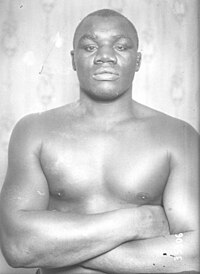
Samuel Edgar Langford, known as the Boston Tar Baby, Boston Terror and Boston Bonecrusher, was a Black Canadian boxing standout of the early part of the 20th century. Called the "Greatest Fighter Nobody Knows", by ESPN, Langford is considered by many boxing historians to be one of the greatest fighters of all time. Originally from Weymouth Falls, a small community in Nova Scotia, he was known as "The Boston Bonecrusher", "The Boston Terror", and his most famous nickname, "The Boston Tar Baby". Langford stood 5 ft 6+1⁄2 in (1.69 m) and weighed 185 lb (84 kg) in his prime. He fought from lightweight to heavyweight and defeated many world champions and legends of the time in each weight class. Considered a devastating puncher even at heavyweight, Langford was rated No. 2 by The Ring on their list of "100 greatest punchers of all time". One boxing historian described Langford as "experienced as a heavyweight James Toney with the punching power of Mike Tyson".

Harry Wills was a heavyweight boxer who held the World Colored Heavyweight Championship three times. Many boxing historians consider Wills the most egregious victim of the "color line" drawn by white heavyweight champions. Wills fought for over twenty years (1911–1932), and was ranked as the number one challenger for the throne, but was denied the opportunity to fight for the title. Of all the black contenders between the heavyweight championship reigns of Jack Johnson and Joe Louis, Wills came closest to securing a title shot. BoxRec ranks him among 10 best heavyweights in the world from 1913 to 1924, and as No.1 heavyweight from 1915 to 1917.

Joe Walcott, also known as Barbados Joe Walcott to distinguish him from the more recent American boxer known by the same name, was a Bajan professional boxer who reigned as the World Welterweight Champion from 1901 to 1906, becoming the first black man ever to capture the title. He was elected to The Ring Boxing Hall of Fame in 1955 and the International Boxing Hall of Fame in 1991.

Sam McVey or Sam McVea was a Hall of Fame heavyweight boxer who fought during the early 20th century. Known as the Oxnard Cyclone, he ranked alongside Jack Johnson, Joe Jeanette, Sam Langford, and Harry Wills as the top black heavyweights of their generation. All of them, except Johnson, were denied a shot at the world heavyweight championship due to the color bar, which ironically was maintained by Johnson when he became the first black fighter to win the world heavyweight title. Despite being denied a title shot, McVea enjoyed a famed career that took him across the globe.
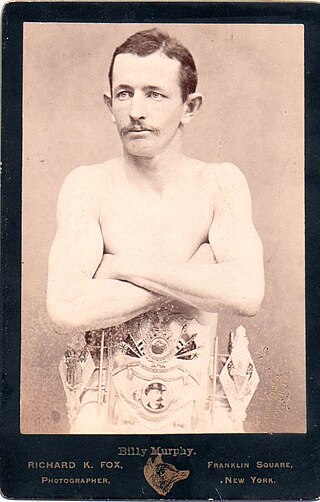
Thomas William Murphy was a New Zealand boxer. An early World Featherweight Champion, he was the first world champion of any weightclass to come from New Zealand. In his early career, he took the New Zealand Lightweight Championship.
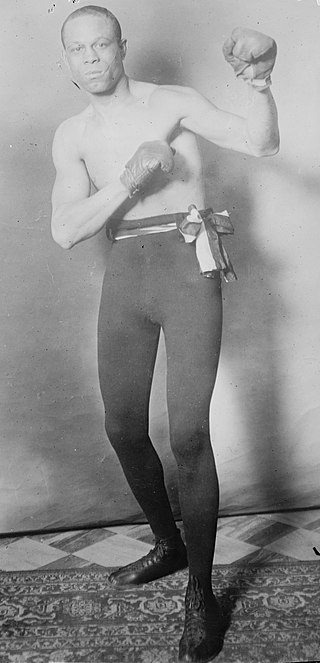
Charles Henry "Jack" Blackburn was an American boxer and boxing trainer. Fighting in the first half of his career as a lightweight and later a welterweight, he was known for an exceptional defense and fought many men above his weight class, including six bouts with the great Sam Langford. He fought Joe Gans three times in no-decision bouts, defeating him once according to newspaper accounts and made good showings against Harry Lewis, Philadelphia Jack O'Brien, and Harry Greb. He found most of his fame training 1937 World Heavyweight Champion Joe Louis, but also had a significant role in training 1926 Lightweight Champion Sammy Mandell. He helped to train World Bantamweight Champion Bud Taylor and World Light-Heavyweight Champion John Henry Lewis as well.

George Henry "Kid" Lavigne was boxing's first widely recognized World Lightweight champion, winning the vacant title on June 1, 1896.

Albert Griffiths, better known as Young Griffo, was a World Featherweight boxing champion from 1890 to 1892, and according to many sources, one of the first boxing world champions in any class. Ring magazine founder Nat Fleischer rated Griffo as the eighth greatest featherweight of all time. He was inducted into the Ring Magazine Hall of Fame in 1954, the International Boxing Hall of Fame in 1991, and the Australian National Boxing Hall of Fame in 2003.

Patrick McFarland, nicknamed "Packey or "Packy", was an American boxer in the lightweight and welterweight divisions. Despite an extraordinary winning record, he was unable to secure a match for either world title. The Ring Record Book and Boxing Encyclopedia suggests McFarland was the best fighter never to become a world champion.
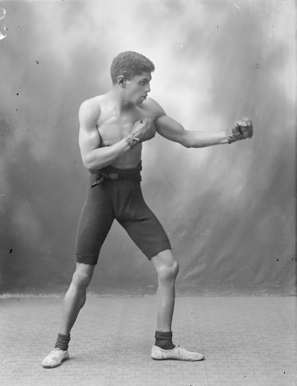
Joseph William Dudley Brown was a South African-born featherweight boxer, better known as Young Pluto, later Joe Pluto, who lived in Australia for most of his life. His career record was 17–9–12.

"Battling" Jim Johnson was an American boxer who fought as a heavyweight from 1908 to 1918. He had little success and lost with great frequency to top boxers such as Sam Langford, Joe Jeanette, Sam McVey, Harry Wills and Kid Norfolk.
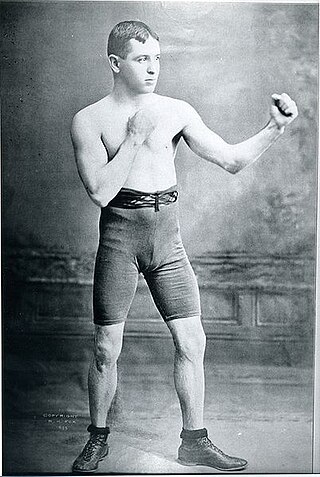
Solomon Garcia Smith was an American professional boxer in the featherweight division. He was a World Featherweight champion and is the first world champion of Hispanic descent.
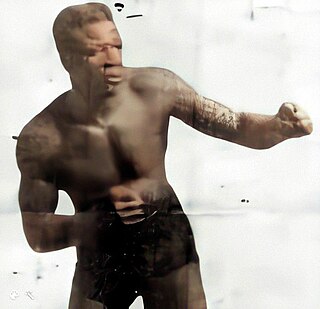
Klondike Haynes was an African American boxer billed as "The Black Hercules" who declared himself the black heavyweight champion. Born John Haines or John W. Haynes, the 6-foot (1.8 m) tall Klondike fought out of Chicago as a heavyweight at a weight of 190–200 pounds (86–91 kg) from 1898 to 1911. He took the nickname because he was supposed to be a great find.
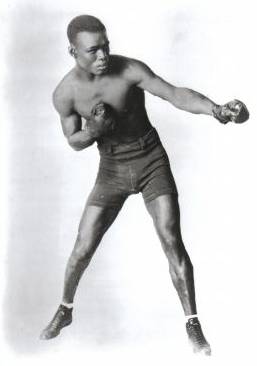
Panama Joe Gans was a black boxer who held the World Colored Middleweight Championship for four years, shortly before it was discontinued. Born Cyril Quinton Jr. on November 14, 1896, in Barbados, British West Indies and raised in the Panama Canal Zone, the 5'7" Quinton originally fought out of Panama and then New York City. He took his ringname from boxing great Joe Gans, the first black American fighter to win a world boxing title. He found his greatest fame fighting as a middleweight at between 147 and 160 lbs, but in his early career he took the Panamanian Lightweight Title and contended for the Panamanian Welterweight Title at weights roughly between 130 and 147 pounds.

William "Matty" Matthews was an American boxer of the early 20th century born and raised in New York City. He was the world welterweight champion twice between 1900 and 1901, and was one of the first boxing world champions to regain his crown. Johnny Dunn, also known as a sports announcer, was his primary manager, particularly during his reign as world welterweight champion.

Jimmy Goodrich became the World Lightweight Champion when he defeated Chilean boxer Stanislaus Loayza in a second round TKO at Queensboro Stadium in Queens, New York on July 13, 1925. He retained the title only five months, losing it by unanimous decision to Rocky Kansas on December 7, 1925. Goodrich was known for having never been the victim of a knockout.

Mike "Twin" Sullivan was an American boxer credited with taking the Welterweight Championship of the World on April 23, 1907, when he soundly defeated William "Honey" Mellody in Los Angeles in a twenty-round bout. He vacated the title in the late fall of 1908, when he could not make weight.

Frank Erne was a Swiss-born American boxer widely credited with taking the World Featherweight Championship on November 27, 1896, from George Dixon in New York City, as well as the World Lightweight Championship from George "Kid" Lavigne on July 3, 1899, in Buffalo, New York. Late in his career he would contend for the World Welterweight Title against Rube Ferns. Erne was posthumously inducted into the International Boxing Hall of Fame in the class of 2020.
Tommy Freeman was an American professional boxer who competed in the 1920s and 1930s. He won the welterweight world championship on September 5, 1930, when he defeated reigning champion Young Jack Thompson. He lost the title to Thompson the following year, on April 14, 1931. Remarkably, the majority of his recorded wins were by knockout, and his losses were few, at under ten percent of his total fights.

Jimmy Walsh was an American boxer who claimed the World Bantamweight Championship on March 29, 1905, when he defeated Monte Attell, in a controversial six-round bout at the National Athletic Club in Philadelphia. His claim was recognized by the World Boxing Association, at the time the National Boxing Association. The fight ended in a disqualification called by the referee when Walsh sent a low right hook that landed below the belt of Attell. Most sources believed Walsh had led throughout the fight and that the blow should have been considered legal, which may be why Walsh was credited with the title by the National Boxing Association.



